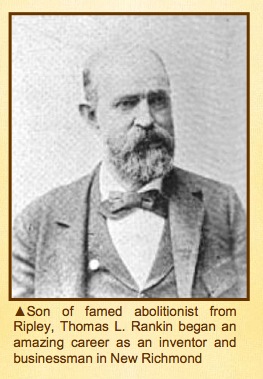|
T.L. Rankin 

The Iceman Son of famed abolitionist from Ripley, Thomas L. Rankin began an amazing career as an inventor and businessman in New Richmond, Ohio. Thomas Lovejoy Rankin was an early pioneer in designing and patenting refrigeration equipment. In 1868 he patented an early refrigerator/freezer that he designed in New Richmond. T. L. Rankin was Thomas Lovejoy Rankin, the youngest son of Rev. John Rankin of Ripley, Ohio, Underground Railroad fame. After moving to New York, Thomas L. Rankin built the first successful indoor ice skating rink in America inside the original Madison Square Garden. Feb.
12, 1879
He later built an "Ice Railway" ride for the 1893 Chicago World's Fair. This innovative ride is referenced by amusement ride historians as a precursor to the modern rollercoaster. T. L. Rankin is credited with some 40 patents in the science of refrigeration. His inventions revolutionized many industries. Rankin was also successful in commercializing his ideas. He began with the building of ice boxes in New Richmond. Besides keeping fruits and vegetables fresh, larger versions of the ice boxes were used by breweries. Rankin’s system of refrigeration enabled the production of lager beer in the summer months as well as in December and January. Previously, due to a lack of practical refrigeration, beer was made only in the winter months. In August 1870,
he brought to Chicago the first carload of dressed beef ever received in warm
weather in good condition from Junction City, Kansas. In 1873, he organized the
Texas and Atlantic Refrigerator Company, and handled 450 head of dressed beef in
trains of ten cars each from Denison, Texas to New York City, those being the
first separate trains of refrigerated beef that ever crossed the
continent. Rankin and Salisbury and Joseph McCoy were key people in making it possible to
ship dressed/slaughtered beef and fresh produce by railroad from Denison.
 Rankin's wife was Charlotte Arminda Salisbury, born on 2 May 1840 in ?, Brown Co., Ohio. She died on 3 Jun 1877 in Near Quenema, Osage Co., Kansas. Charlotte was a sister of Dr. William Wiley Salisbury. In the early 1870s, he was superintendent of the Arctic Ice Company of Denison, Texas (listed in Denison City Directory for 1876-77). Charlotte married Thomas Lovejoy Rankin on 12 May 1862 in Brown Co., Ohio. Thomas was born on 16 Jan 1839 in Ripley, Brown Co., Ohio. He died on 22 Nov 1915. They had the following children
Syracuse Herald
SON OF ABOLITONIST LEADER EXPIRES AT SACKET HARBOR In The Home Of Thomas L. Rankin's Father, Facts For Uncle Tom's Cabin Were Obtained Watertown, Nov. 13 - Thomas L. Rankin, a son of the famous abolitionist leader of the decade preceding the Civil war, the Rev. John Rankin of Kentucky, to whose home the "Eliza" of Uncle Tom's Cabin fame fled with her little son across the ice of the Ohio, died last evening at his home at Sacket Harbor where for the past 26 years, he had spent the summer months, after a three weeks' illness from hardening of the arteries, aged 76 years and five months. Mr. Rankin, who was an inventor of several hundred successful devices and who had long ago been able to retire from active business, had for the past twenty-six years made Sacket Harbor his home in summer, spending his winters in different sections of the South. He was intimately connected with the establishment of the principle of refrigeration in the shipment of produce to market and as an inventor had been more or less associated with the manufacture of refrigerating machinery. When the application of refrigeration was first being made to commercial use, Mr. Rankin, to illustrate the operation of refrigeration by the brine process, flooded and froze over the interior of Madison Square Garden in New York and used it for a public skating rink for about a month. He also maintained an ice railway at the Chicago's Worlds Fair and later at Coney Island. The latter railway was wrecked by a severe storm and tidal wave at a loss of about $60,000. He was a member of Sacket Harbor Lodge, No. 135, F. & A.M., and of Sacket Harbor Chapter, R.A.M. He leaves besides his widow, Mrs. Alice Rankin, one son, John T. Rankin of Quenemo, California; and three daughters - Mrs. T. W. Baird of Denver, Colorado; Miss Lottie J. Rankin, a teacher of Spirit Lake, Idaho, and Mrs. O. R. Ashby, of Cadoa, Colorado. Thomas L. Rankin was born in Ripley, Ohio, and was the last remaining member of the family of 13 children of the Rev. John Rankin, Presbyterian clergyman, abolitionist advocate, and prominent educator of the southwest in the days before the war. The funeral arrangements have not yet been made. FORCED TO LEAVE SOUTH The Rankin family previous to the war lived in Tennessee and Kentucky, but owing to the abolition efforts of the Rev. John Rankin, he was forced to take refuge in the free State of Ohio, locating on the north bank of the river at the little town of Ripley, midway between Portsmouth and Cincinnati. The
home of the Rev. John Rankin stood at the very pinnacle of the high bluff along
the northern side of the Ohio River, on which the village of Ripley was
situated, the point towering 450 feet above the southern, or Kentucky shore at
that point. Beside his house, John Rankin, with the aid of his abolitionist
neighbors, erected about 1840 a lofty pole seventy-five feet high, fitted with
halyards, and it was the custom every evening to haul to the top of this pole a
big fish oil lantern, the light of which could be seen for many miles across
the Kentucky blue grass bottom lands. In a short time this beacon became known
to the slaves on every Kentucky plantation, and news of it was imparted by them
to runaway slaves fleeing northward for Canada, where under the Union Jack, all
men were free and equal. Hiding in cane brakes, or secreted in negro cabins by
day, the fugitive slaves at night plodded across tobacco fields and through swamps
toward Rankin's beacon of liberty. The Rankin house became the principle station on the famous "Underground Railway" of Civil War times and hundreds of colored people were here aided and protected in their flight from slavery. It is said that no slave that ever reached Ripley, bound for the Canadian line was ever recaptured. The fame of the Rankin house was widespread throughout the South. The runaway negro knew that he was sure of friendly succor if he could only reach the shelter of its walls. The Southern slaveholders also knew and hated the daring Abolitionists, and for many years preceding the war and until its close the Rankin house was made the target of many a Southern rifle and its occupants were in constant danger of ambush and death. After their removal to Ohio frequent attempts were made by Kentucky slavery adherents to burn the Rankin buildings and kill the members of the household. Capt. R. C. Rankin, one of the sons, was shot through the shoulder one evening while repelling an attack. But persecution and peril could not drive the intrepid John Rankin from his work and he continued his labors in aiding the slaves to escape from bondage until Lincoln's hand loosened the shackles from the captive limb. GATHERED FACTS FOR STORY The Rev. John Rankin continued as pastor of the Presbyterian church at Ripley for forty-four years and he was always fearless and untiring in and out of the pulpit in his efforts to advance the cause of freedom. It was at the Rankin house that Harriet Beecher Stowe gathered the facts of the story of Eliza in her great historic novel, "Uncle Tom's Cabin." Mrs. Stowe was an intimate friend of the Rankins' and made many visits to their hospitable home while writing the famous work. The story of Eliza and her thrilling escape across the breaking ice of the swollen waters of the Ohio, is founded on fact and it was at the Rankin house that she found shelter on her wild flight to save her child. Eliza was a mulatto woman owned by a kind Kentucky master. By reason of severe financial difficulties, he was about to sell Eliza's two year old boy down the river. Hearing of this Eliza determined to save her child and hurried northward at night. When she reached the Ohio she found that the floating ice in the river was melting and breaking up. Thinking that crossing might be less dangerous in the morning, she decided to remain over night at the home of a friendly family in the south bank of the river, opposite the town of Ripley. But a rumor came of the near approach of her pursuers, and seizing her sleeping babe, she ran to the river and leaped onto the breaking ice. It was a perilous undertaking but at last she reached the Ohio side in safety and was directed to the Rankin household, where she was given shelter, and then hurried northward on the Underground Railway. She was taken to the house of Levi Coffin in Newport, Indiana, where she resided several days and was afterwards taken to Chatham, Canada. While at the home of Mr. Coffin she was given the name of Eliza Harris. Mr. and Mrs. Coffin visited her in later years. 
Biography Index Denison History Copyright © 2024, TXGenWeb. If you find any links inoperable, please send me a message. |